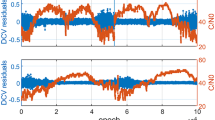Abstract
The global navigation satellite system (GNSS) spoofing technology is an important method to control the targets that pose threats and protect sensitive areas. Traction spoofing can gradually take over the tracking loop by spoofing signals. To achieve more covert spoofing of a receiver configured with phase lock loop (PLL) assisted delay lock loop (DLL) loop, the following research work has been carried out: First, the response of the combined loop to GNSS spoofing is analyzed; Second, a new asynchronous traction signal spoofing algorithm is proposed; in the design of the code rate and carrier frequency of spoofing signal, the dynamic performance of the loop is fully considered, while maintaining a good consistency with the carrier frequency. In the design of the power of the spoofing signal, the success rate of spoofing is improved as much as possible while avoiding absolute power monitoring. Finally, the calculation method of the parameters of the spoofing signal is given. Third, by building the GNSS signal generation software and software receiver platform to carry out experimental verification and through experimental comparison and analysis with many existing representative spoofing schemes, it is proved that the new algorithm can successfully achieve spoofing. The spoofing takes 107.8 s, which makes the local code rate increase 0.03 Hz, the carrier frequency increase 50 Hz, the average value of consistency spoofing detection is 9.40 × 10−3, and finally stabilized at the convergence value − 2.95 × 10−8, that is, during the spoofing process, spoofing signal maintains the consistency of the authentic signal, which can well avoid the consistency spoofing detection of the receiver, the effectiveness and superiority of the proposed algorithm compared with other spoofing methods are fully verified.


















Similar content being viewed by others
Data and material availability
Data will be available on request to the corresponding author.
References
Bamberg T, Appel M, Meurer M (2018) Which GNSS tracking loop configuration is most robust against spoofing? In: Proceedings of ION GNSS 2018, Institute of Navigation, Miami, Florida, USA, p 3587–3595. 24–28 September
Gamba M, Truong M, Motella B, Falletti E, Ta T (2016) Hypothesis testing methods to detect spoofing attacks: a test against the TEXBAT datasets. GPS Solut 21(2):577–589. https://doi.org/10.1007/s10291-016-0548-7
Gao Y, Li H, Lu M, Feng Z (2013) Intermediate spoofing strategies and countermeasures. Tsinghua Sci Technol 18(6):599–605.https://doi.org/10.1109/TST.2013.6678905
Gao Y, Lv Z, Zhang L (2020) Asynchronous lift-off spoofing on satellite navigation receivers in the signal tracking stage. IEEE Sens J 20(15):8604–8613. https://doi.org/10.1109/JSEN.2020.2984525
Guo Y, Wu M, Tang K, Tie J, Li X (2019) Covert spoofing algorithm of UAV based on GPS/INS integrated navigation. IEEE Trans Veh Technol 68(7):6557–6564. https://doi.org/10.1109/TVT.2019.2914477
Huang K, Wang H (2018) Combating the control signal spoofing attack in UAV systems. IEEE Trans Veh Technol 67(8):7769–7773. https://doi.org/10.1109/TVT.2018.2830345
Huang L, Lv Z, Wang F (2012) Spoofing pattern research on GNSS receivers. J Astronaut 33(7):884–890. https://doi.org/10.3873/j.issn.1000-1328.2012.07.005
Humphreys TE, Ledvina BM, Psiaki ML, O'Hanlon BW, Kintner PM (2008) Assessing the spoofing threat: development of a portable GPS civilian spoofer. In: Proceeding of the ION GNSS 2008, Institute of Navigation, Savanna, GA, USA, p 2314–2325, 16–19 September
Humphreys TE, Bhatti J, Shepard D, Wesson K (2012) The Texas spoofing test battery: toward a standard for evaluating GPS signal authentication techniques. In: Proceeding of the ION GNSS 2012, Institute of Navigation, Nashville, TN, USA, p 3569–3583, 18–21 September
Jafarnia-Jahromi A, Tao L, Broumandan A, Nielsen J, Lachapelle G (2012) Detection and mitigation of spoofing attacks on a vector based tracking GPS receiver. In: Proceeding of the ION ITM 2012, Institute of Navigation, Newport Beach, CA, USA, p 790–800, Jan 30–Feb 1
Jahromi AJ, Broumandan A, Nielsen J, Lachapelle G (2012) GPS spoofer countermeasure effectiveness based on signal strength, noise power, and C/N0 measurements. Int J Satell Commun Network 30:181–191. https://doi.org/10.1002/sat.1012
Ma C, Yang J, Chen J, Qu Z, Zhou C (2020) Effects of a navigation spoofing signal on a receiver loop and a UAV spoofing approach. GPS Solut 24:76. https://doi.org/10.1007/s10291-020-00986-z
Peng C, Li H, Lu M (2019) Research on the responses of GNSS tracking loop to intermediate spoofing. In: Proceeding of the ION GNSS 2019, Institute of Navigation, Miami, Florida, USA, p 943–952, 16–20 September
Peng C (2020) Research on key technologies of GNSS intermediate spoofing. Dissertation, Tsinghua University.
Suzuki T, Kubo N (2014) GNSS-SDRLIB: An open-source and real-time GNSS software defined radio library. In: Proceeding of the ION GNSS 2014, Institute of Navigation, Tampa, Florida, USA, 1364–1375, 8–12 September
Xie G (2009) Principles of GPS and receiver design, vol 2009. Publishing House of Electronics Industry, Beijing, pp 321–322 (ISBN: 978-7-121-09077-6 )
Zhang X, Li H, Yang C, Lu M (2021) Influence of spoofing interference on GNSS vector tracking loops. J Tsinghua Univ (sci Technol) 62(01):163–171. https://doi.org/10.16511/j.cnki.qhdxxb.2021.21.023
Zhou M, Li H, Lu M (2018) Calculation of the lower limit of the spoofing-signal ratio for a GNSS receiver spoofer. EURASIP J Wirel Commun Netw 1:44. https://doi.org/10.1186/s13638-018-1048-y
Zhou M, Li H, Wang C, Ma T, Lu M (2019) Induced spoofing detection of global navigation satellite system. J Natl Univ Def Technol 41(04):129–135. https://doi.org/10.11887/j.cn.201904019
Acknowledgements
This research was funded by the National Natural Science Foundation of China, Grant number 42071454 and was also funded by the State Key Laboratory of Geo-Information Engineering, Grant number SKLGIE2020-Z-2-1.
Author information
Authors and Affiliations
Contributions
YG and GL wrote the main manuscript text. All authors reviewed the manuscript.
Corresponding author
Ethics declarations
Competing interests
The authors declare no competing interests.
Additional information
Publisher's Note
Springer Nature remains neutral with regard to jurisdictional claims in published maps and institutional affiliations.
Rights and permissions
Springer Nature or its licensor (e.g. a society or other partner) holds exclusive rights to this article under a publishing agreement with the author(s) or other rightsholder(s); author self-archiving of the accepted manuscript version of this article is solely governed by the terms of such publishing agreement and applicable law.
About this article
Cite this article
Gao, Y., Li, G. A new asynchronous traction signal spoofing algorithm for PLL-assisted DLL receiver. GPS Solut 27, 141 (2023). https://doi.org/10.1007/s10291-023-01478-6
Received:
Accepted:
Published:
DOI: https://doi.org/10.1007/s10291-023-01478-6




